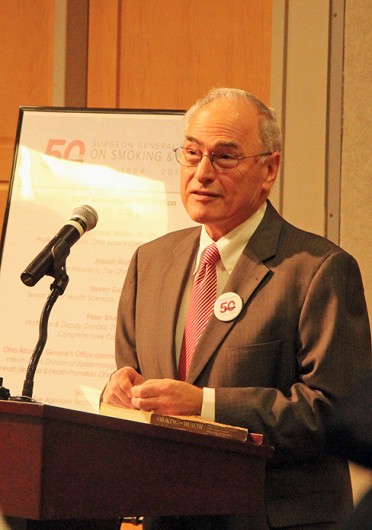
OSU Interim President Joseph Alutto speaks at an event commemorating the 50th anniversary of the initial U.S. Surgeon General Report outlining the effects of smoking.
Credit: Abdulrahman Al-Ruwaishan / Lantern photographer
Ohio State’s tobacco-ban is kicking into effect 50 years after research that highlighted negative associated health risks was first released.
OSU commemorated the 50th anniversary of the initial U.S. Surgeon General Report at an event Friday.
Surgeon General Dr. Luther Terry released a report that concluded cigarette smoking was a cause of lung cancer and a significant health risk Jan. 11, 1964.
More than 100 people gathered at the Ohio Union Friday to celebrate a landmark anniversary of the report that contributed to changing the public perception of smoking tobacco. Since the release of the initial Surgeon General Report, the number of adults who smoke has dropped to 18 percent from more than 42 percent in 1964.
Friday’s event was expected to cost approximately $5,000, covering room rentals, food and program materials, said Bri Loesch, a spokeswoman for the College of Public Health.
OSU Interim President Joseph Alutto said at the event the issues of smoking are complicated and there is still a long fight left toward decreasing the amount of adult smokers.
“Smoking is a complex societal problem that can only be impacted by strong social movements to bring awareness to the complications of smoking,” Alutto said. “We have just implemented a smoke-free campus effective this year so we should take the time to celebrate what we have accomplished in deterring smoking and we still have a lot of work left to do.”
The ban was announced in 2013, and was set to take effect Aug. 1. However, in August university officials said the ban would not be enforced until 2014.
One of the features of Friday’s event included presenting formal research on a wide variety of smoking-related topics, which included manipulative marketing and the First Amendment, non-daily smoking patterns in young adults and effects of secondhand smoke on healthcare utilization among children.
Julianna Nemeth, a program manager at the College of Public Health, has focused her research on the effects of physical and sexual abuse of women and how smoking is intertwined with these types of abuse.
“If you look at current women smokers in the Ohio Appalachia area, 78 percent who smoke have either been physically or sexually abused in their lifetime,” Nemeth said. “A person’s social and cultural environment can predispose them to smoke and we are trying to figure out how to fight these exposures.”
Since the initial release of the report in 1964, there have been an estimated 17.7 million deaths related to smoking and an estimated 8 million fewer premature smoking-related deaths than what would have occurred without the presentation of information to combat smoking, according to a study in the Journal of the American Medical Association .
Claire Bollinger, a third-year Ph.D. student in environmental health sciences, said people should establish the practice of ignoring tobacco at an early stage in life.
“One way to prevent smoking in society is to make sure children aren’t exposed to any form of media involving smoking cigarettes,” Bollinger said. “My mother made my dad smoke outside and as a child it helped me form this idea that if he has to go outside to smoke then it must be bad for you.”
The top four leading causes of death in the U.S. — heart disease, cancer, lung ailments and strokes — are often linked to harmful effects of smoking. The Food and Drug Administration has said it will commit $300 million on ads, some of which will specifically target teenagers, in 2014-15 as a way to discourage smoking.
OSU has spent $43,000 of a $100,000 budget to make sure visitors to campus know about the tobacco ban with signs and banners around campus.
Opponents of smoking, including lobbyists and special interest groups, continue to fight tobacco companies, aiming to make it harder for producers and consumers to sell and purchase cigarettes. Stronger regulations of tobacco products, higher tobacco taxes, massive public health campaigns and graphic imaging on cigarette packs are a few ways opponents are trying to alter the culture of smoking and deter people from either starting or continuing to smoke.
Dr. Steven Gabbe, senior vice president for health services at the Wexner Medical Center, said society is heading toward the bigger picture in the ongoing fight to curb Americans from the negative effects of smoking.
“Smoking is something that has to stop sooner rather than later and it is important to continue our work within the health professional world,” Gabbe said. “My hope is 50 years from now people are only reading about the past effects of smoking and we live in a smoke-free society.”

